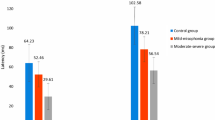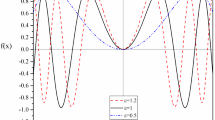Abstract
According to the vibration characteristics of the organ of Corti (OC), seven hypotheses are made to simplify the structure of the model, and a mechanical OC model is established. Using the variational principle, a displacement analytical expression is solved under a certain pressure. The results are in good agreement with experimental data, showing the validity of the formula. Combined with the damage caused by noise in clinic, it is found that the hardening of outer hair cells and outer stereocilia can lead to loss of hearing and generation of threshold shift. In addition, the results show that high frequency resonance occurs at the bottom of the basilar membrane (BM), and low frequency resonance occurs at the top of the BM. This confirms the frequency selective characteristics of the BM. Further, using this formula can avoid interference of the envi- ronment and the technical level of the test personnel, and can evaluate performance of the OC objectively.
Similar content being viewed by others
References
Holley, M. C. and Ashmore, J. F. A cytoskeletal spring in cochlear outer hair cells. nature, 335, 635–637 (1988)
Tolomeo, J. A., Steele, C. R., and Holley, M. C. Mechanical properties of the lateral cortex of mammalian auditory outer hair cells. Biophysical Journal, 71, 421–429 (1996)
Chan, E., Suneson, A., and Ulfendahl, M. Acoustic trauma causes reversible stiffness changes in auditory sensory cells. Neuroscience, 83, 961–968 (1998)
Hallworth, R. Passive compliance and active force generation in the guinea pig outer hair cell. Journal of Neurophysiology, 74, 2319–2328 (1995)
Zwislocki, J. J. and Cefaratti, L. K. Tectorial membran II: stiffness measurements in vivo. Hearing Research, 42, 211–227 (1989)
Edge, R. M., Evans, B. N., Pearce, M., Richter, C. P., Hu, X., and Dallos, P. Morphology of the unfixed cochlea. Hearing Research, 124, 1–16 (1998)
Naidu, R. C. and Mountain, D. C. Longitudinal coupling in the basilar membrane. Journal of the Association for Research in Otolaryngology, 2, 257–267 (2001)
Brundin, L., Flock, A., and Canlon, B. Sound-induced motility of isolated cochlear outer hair cells is frequency-specific. Nature, 342, 814–816 (1989)
De Boer, E. On active and passive cochlear models: towards ageneralized analysis. Journal of the Acoustical Society of America, 73, 574–576 (1983)
Diependaal, R. J. and Viergever, M. A. Nonlinear and active two-dimensional cochlear models: time-domain solution. Journal of the Acoustical Society of America, 85, 803–812 (1989)
Kanis, L. J. and de Boer, E. Comparing frequency-domain with time-domain solutions for a locally active nonlinear model of the cochlea. Journal of the Acoustical Society of America, 100, 2543–2546 (1996)
Kanis, L. J. and de Boer, E. Frequency dependence of acoustic distortion products in a locally active model of the cochlea. Journal of the Acoustical Society of America, 101, 1527–1531 (1997)
Zweig, G. Finding the impedance of the organ of Corti. Journal of the Acoustical Society of America, 89, 1229–1254 (1991)
Allen, J. B. and Fahey, P. F. A second cochlear-frequency map that correlates distortion product and neural tuning measurements. Journal of the Acoustical Society of America, 94, 809–816 (1993)
Lim, K. M. and Steele, C. R. A three-dimensional nonlinear active cochlear model analyzed by the WKB-numeric method. Hearing Research, 170, 190–205 (2002)
Yoon, Y., Puria, S., and Steele, C. R. Intracochlear pressure and organ of Corti impedance from a linear active three-dimensional model. Oto-Rhino-Laryngology, 68, 365–372 (2006)
Liberman, M. C. The cochlear frequency map for the cat: labeling auditory-nerve fibers of known characteristic frequency. Journal of the Acoustical Society of America, 72, 1441–1449 (1982)
Muller, M. The cochlear place-frequency map of the adult and developing mongolian gerbil. Hearing Research, 94, 148–156 (1996)
Greenwood, D. D. Critical bandwidth and the frequency coordinates of the basilar membrane. Journal of the Acoustical Society of America, 33, 1344–1356 (1961)
Greenwood, D. D. Comparing octaves, frequency ranges, and cochlear-map curvature across species. Hearing Research, 94, 157–162 (1996)
Masayoshi, A. and Hiroshi, W. Prediction of the characteristics of two types of pressure waves in the cochlea: theoretical considerations. Journal of the Acoustical Society of America, 116, 417–425 (2004)
Robles, L. and Ruggero, M. A. Mechanics of the mammalian cochlea. Physiological Reviews, 81, 1305–1352 (2001)
Olson, E. S. Direct measurement of intra-cochlear pressure waves. nature, 402, 526–529 (1999)
Yang, L., Hua, C., Dai, P. D., Yan, X. Q., Zhang, T. Y., Ding, G. H., Wang, K. Q., and Wang, Z. M. Two dimensional FEM analysis for dynamic behavior of the organ of Corti (in Chinese). Journal of Vibration and Shock, 27, 108–111 (2008)
Zagadou, B. F., Barbone, P. E., and Mountain, D. C. Elastic properties of organ of Corti tissues from point-stiffness measurement and inverse analysis. Journal of Biomechanics, 47, 1270–1277 (2014)
Cai, H., Shoelson, B., and Chadwick, R. S. Evidence of tectorial membrane radial motion in a propagating mode of a complex cochlear model. Proceedings of the National Academy of Sciences, 101, 6243–6248 (2004)
Wang, Z. L., Wang, X. L., Hu, Y. J., Shi, H., and Cheng, H. M. FEM simulation of sound transmission based on integrated model of middle ear and cochlea. Chinese Journal of Biomedical Engineering, 30, 60–66 (2011)
Nakajima, H. H., Ravicz, M. E., Rosowski, J. J., Peake, W. T., and Merchant, S. N. Experimental and clinical studies of malleus fixation. The Laryngoscope, 115, 147–154 (2005)
Dai, C., Cheng, T., Wood, M. W., and Gan, R. Z. Fixation and detachment of superior and anterior malleolar ligaments in human middle ear: experiment and modeling. Hearing Research, 230, 24–33 (2007)
Author information
Authors and Affiliations
Corresponding author
Additional information
Project supported by the National Natural Science Foundation of China (Nos. 11272200 and 11572186)
Rights and permissions
About this article
Cite this article
Chen, Y., Yao, W. & Liu, S. Mechanical model of organ of Corti. Appl. Math. Mech.-Engl. Ed. 38, 867–876 (2017). https://doi.org/10.1007/s10483-017-2203-8
Received:
Revised:
Published:
Issue Date:
DOI: https://doi.org/10.1007/s10483-017-2203-8
Key words
- organ of Corti (OC)
- variational principle
- hardening of outer hair cells (OHCs)
- hardening of outer stereocilia
- threshold shift




